The x86 Power Myth Busted: In-Depth Clover Trail Power Analysis
by Anand Lal Shimpi on December 24, 2012 5:00 PM ESTSunSpider 0.9.1
Now the fun stuff. Doing power profiles of our standard benchmarks gives us good insight into how well each vendor was able to balance peak performance and average power. In general it's ok to burn more power for a short amount of time as long as it means you'll get to sleep quicker. This was one of the fundamentals of the first transition to mobile from the early 2000s.
We already know that Intel completes SunSpider quicker thanks to its improved memory subsystem over the Cortex A9, but it also does so with much better average power (3.70W vs. 4.77W for this chart). A big part of the average power savings comes courtesy of what happens at the very tail end of this graph where the W510 is able to race to sleep quicker, and thus saves a good deal of power.
| JavaScript Performance | |||||||
| Time in ms (Lower is Better) | Kraken | SunSpider | RIA Bench Focus | ||||
| Acer W510 (Atom Z2760 1.8GHz) | 33220.9ms | 730.8ms | 3959ms | ||||
| Microsoft Surface (Tegra 3 1.3GHz) | 49595.5ms | 981.1ms | 5880ms | ||||
| Samsung ATIV Smart PC (Atom Z2760 1.8GHz) | 33406.0ms | 721.3ms | 3752ms | ||||
| Apple iPad 4 (A6X) | 19086.9ms | 834.7ms | - | ||||
| Google Nexus 10 (Exynos 5 Dual) | 11146.0ms | 1384.1ms | - | ||||
I also used SunSpider as an opportunity to validate the results from Intel's tablets with my own review samples. To generate this chart I measured power, every second, at the wall with both devices plugged in and with a fully charged battery. The resulting power consumption numbers include the efficiency loss at the AC adapter but the general curve shoud mimic the results above:
Note that the results do generally line up, although measuring at the battery gives more accurate results for the device and using the NI DAQ I was able to get better granularity on the power measurements.
Looking at CPU level power consumption we see a very even match between Atom and Tegra 3. Intel's advantage really comes from being able to complete the workload quicker (0.52W compared to 0.72W on average).
Once again we see a pretty significant difference in power consumption on the GPU rail between these two platforms.
Kraken
Mozilla's Kraken benchmark is a new addition to our js performance suite, and it's a beast. The test runs for much longer than SunSpider, but largely tells a similar story:
RIABench
RIABench's Focus Tests are on the other end of the spectrum, and take a matter of seconds to complete. What we get in turn is a more granular look at power consumption:




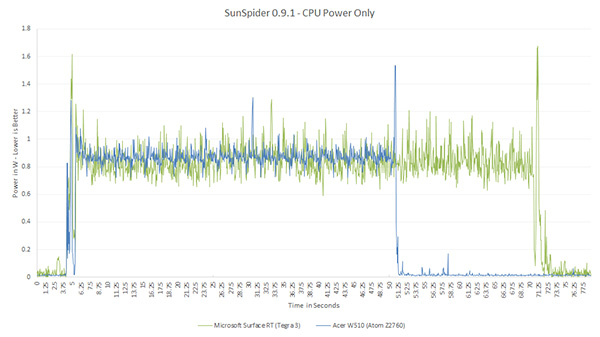

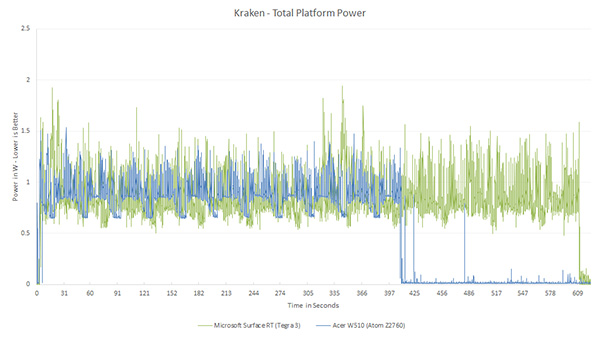
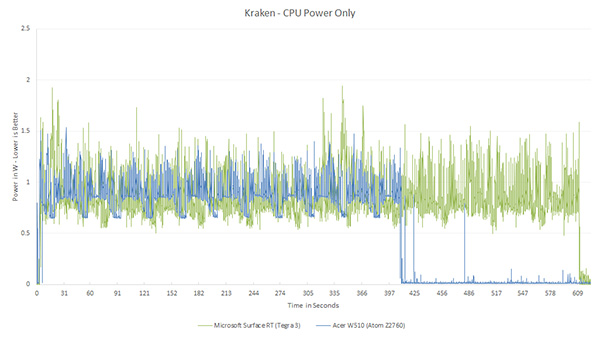

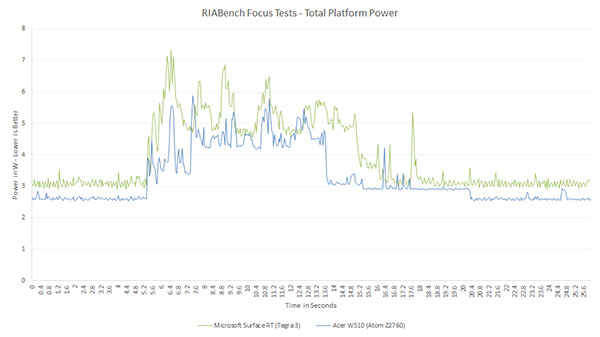
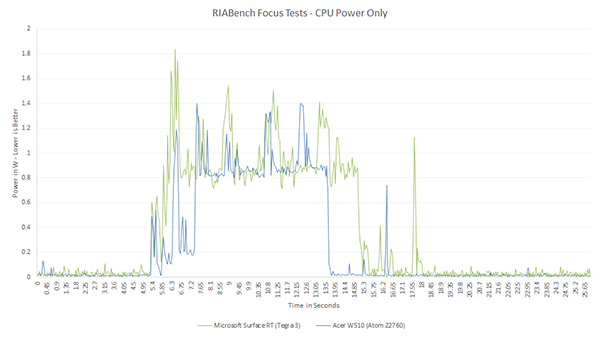
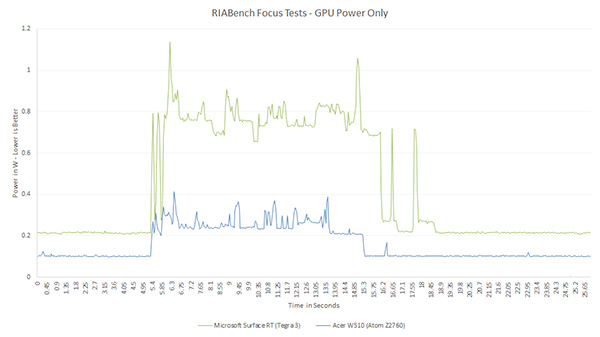








163 Comments
View All Comments
felixyang - Friday, December 28, 2012 - link
You get the keypoint.st.bone - Tuesday, December 25, 2012 - link
Now that's just out right ignorant on your comment, that's if you even took the time to read the articlejeffkibuule - Monday, December 24, 2012 - link
This kind of makes me shake my head as to why a year old SoC was used when Samsung was shipping Exynos 5250 and Qualcomm had APQ8064, heck nVidia has Tegra4 just waiting in the wings for a likely CES announcement (I know why, bad timing).My only hope is that in 2013, ARM and Atom SoCs can support 1080p displays, I don't think I can use anything less without wanting to poke my eyes out.
kyuu - Monday, December 24, 2012 - link
Agreed. This article mostly highlights what an out-of-date SoC Tegra3 is, and how bad it is without its companion core. Which is why its so perplexing that Microsoft went with the Tegra 3 for the Surface. I can only guess that Nvidia must be practically giving away Tegra3 nowadays, otherwise I have no idea why anyone would use it.I'm not sure it's a huge win for Intel that Clover Trail beats a mostly obsolete ARM SoC in power use with such an incredibly mediocre GPU.
A more interesting comparison would be between a current-gen Qualcomm chipset and/or Samsung's current-gen Exynos.
kyuu - Monday, December 24, 2012 - link
To clarify the second "paragraph", Clover Trail is the one with the mediocre GPU.lmcd - Tuesday, December 25, 2012 - link
They're both mediocre GPUs at this point. Didn't Adreno 225 keep pace with the T3 GPU?jeffkibuule - Tuesday, December 25, 2012 - link
The reasoning for going for Tegra 3 was pretty obvious. They needed a more finalized chip to develop Windows RT against and Tegra 3 was the only thing available. Relying on a faster class of SoCs in the Tegra 4, Snapdragon S4 Pro, or Exynos 5250 would mean delaying the Windows RT version of tablets by several months at least since I doubt development would have been done in time.lmcd - Tuesday, December 25, 2012 - link
S4 standard would've done better more likely. Clover Trail demo'ed how viable two cores was for W8, let alone W8 RTwsw1982 - Tuesday, December 25, 2012 - link
There is already the comparison between the medfield, krait, swift and Exynos 5250 on the android platform, isn't there? I think microsoft is the one to blame that you can only compare clover trails and tegra 3 on windows platform, LOLKrysto - Monday, December 24, 2012 - link
Intel will not have anything that even approaches next year's ARM SoC's GPU's anytime soon. And they can't match Cortex A15 in performance anytime soon either.